Best of India Tours
- Golden Triangle Tour- Best of India & Nepal
- Classical Rajasthan
India Cultural Tours
- Images of North India- Karnataka Heritage
- Rajasthan & Goa Tour
Discover India Tours
- Grand India Tour- North to South India
- Central to South India
Rajasthan Tours
- Classical Rajasthan Tour- Golden Triangle Tour
- Grand Mughal Tour
India Luxury Trains
- Palace on Wheels- The Golden Chariot
- India Deccan Odyssey
- The Indian Maharaja
- Royal Rajasthan on Wheels
Nepal Tours
- Glimpses of Nepal- Buddhist Pilgrimage
- Nepal River Rafting
- Destinations of Nepal
- Nepal General Info
India Wildlife Tours
- North India Wild Life- South India Wildlife
Tibet Tours
- Tibet Monastery Tours- Explore Tibet
- Destinations of Tibet
Spa & Yoga Tours
- Ananda in Himalayas- Yoga & Meditation
Adventure Tours
- Manali Safari Tour- Himalayan Trekking
- Horse Safari
India Fairs & Festivals
Dussehra
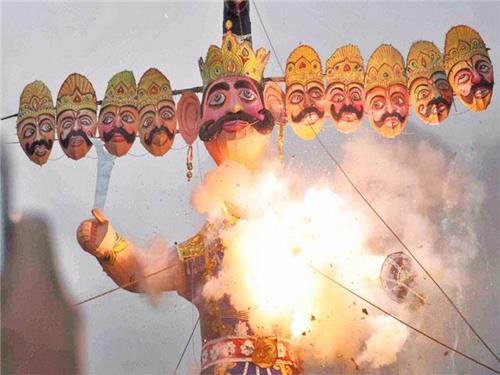
It is the nine days festival, which signifies the victory of Good over Evil. As diverse as India is, it is but natural that Good and Evil take various forms in different parts of the country. Central and North India celebrate Lord Rama’s victory over the ten-headed Ravana. In the East, in west Bengal, this festival marks the victory of Goddess Durga over the demon Mahishasura. In the state of Himachal, a week long fair at Kullu is a part of the Dussehra celebrations. From the little temples in the hills, deities are brought in procession to the Kullu Fair ground with a lot of gaiety, music and colour. Down South in the city of Mysore, the exotic and colourful celebration of Dussehra leaves many a visitor enthralled.
Deepavali
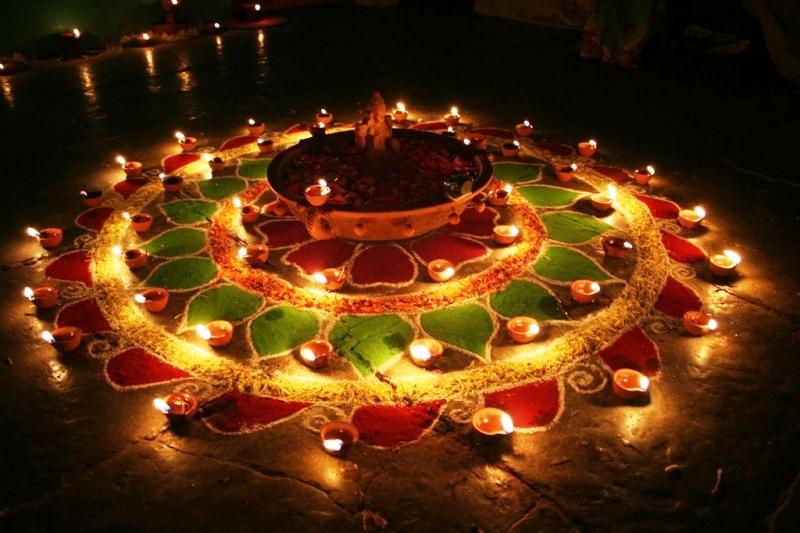
Literally meaning “an array of lamps”, it is the Festival of Lights and perhaps the only festival that is celebrated along the length and breadth of the country without any diversity as well as amongst Indians all over the world. This is an occasion for the young and old, men and women, rich and poor-for every one, irrespective of their religious and economic backgrounds. This festival is celebrated throughout the country to ward off the darkness and welcome the light to their lives. This festival is celebrated to mark the return of Lord Rama, his consort Sita and brother Lakshmana, to their kingdom after 14 years of exile.
To celebrate their return, the people of Ayodhya are believed to have lit up their houses and streets with lamps and the tradition is followed till date. People also conduct Lakshmi Puja to please the Goddess of Wealth.
Holi
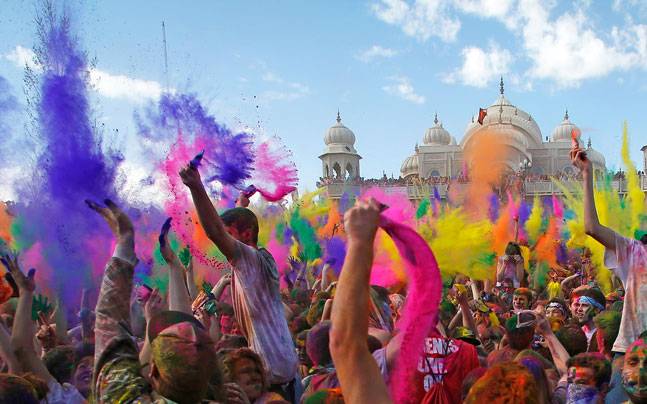
The festival of Holi symbolizes the victory of good over evil. It also marks the advent of spring and people celebrate it joyously with a splash of color. It is the most boisterous of all Hindu festivals, observed all over India, especially the North. It heralds the end of winter and the beginning of spring. The night before the full moon, crowds of people gather together and light huge bonfires to burn the residual dried leaves and twigs of the winter. People throw colored water with pichkaari (a traditional device to spray coloured water), gubbare (balloons filled with coloured water) and gulal (colour powder) at each other and make merry.
Singing and dancing add to the gaiety of the occasion. In the northern, western and eastern regions, Holi celebrates the joyful Raasleela (dance) of Lord Krishna and the Gopis. Holi, also known as phag, is a joyous celebration of the rejuvenation of nature and renewed hope of happiness and peaceful coexistence.Especially famous is the lathmaar Holi of Barsana and Nandgaon. In Anandpur Sahib in Punjab, Sikhs celebrate a special festival called Hola Mohalla on the day after Holi. It marks a display of ancient martial arts and mock battles. Holi is also an occasion for the celebration of the burning of Lord Kama, the Hindu equivalent of Cupid, with the fire that emanated from Lord Shiva's third eye and also symbolizes the burning of demoness Holika. Till date people burn effigies of Holika.
Maha Shivaratri
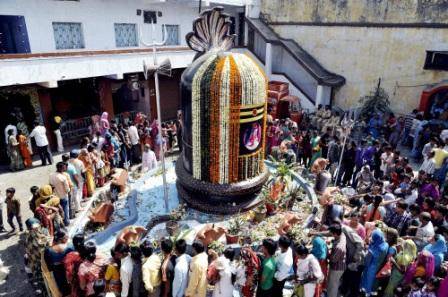
The festival of Maha Shivratri falls on the 13th (or 14th) day of the month of Phalguna (February–March) of the Indian calendar. The weather remains pleasant throughout India during this time of the year. The word Shivratri literally translates into "the night of Shiva.” This is because the ceremonies take place chiefly at night. A daylong fast, a nightlong vigil, and the reverberating rhythm of sacred chants mark the day. This is a festival observed in honor of Lord Shiva. It is said that Lord Shiva married Goddess Parvati on this auspicious day.
The Shiva Lingam is worshipped throughout the night by washing it every three hours with milk, curd, honey, rose water, etc., whilst the chanting of the Mantra “Om Namah Shivaya” continues. Offerings of bael leaves are made to the Shiva Linga. Bael leaves are very sacred, for it is believed that Goddess Lakshmi resides in them.
Janmashtami
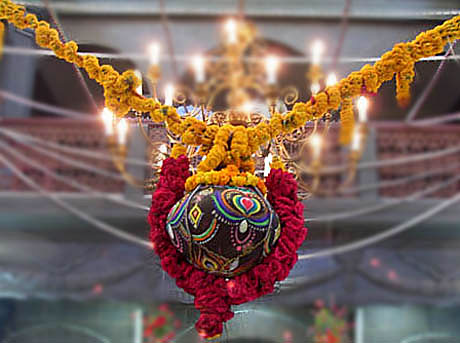
This festival associated with Lord Krishna’s birthday and is a combination of religion and celebration together. This festival is celebrated all over India especially among Hindus. Mathura, the ancient north Indian town, is Krishna’s birthplace, and it is one of the most sacred places in the entire country. People celebrate this festival with fun, frolic, and merrymaking. The raasleelas, bhajan, kirtan, and various local functions are the special attractions of the place. The festival of Janmashtami is celebrated during the month of August or September depending on the Indian calendar.
The celebration of this festival is followed according to the Indian calendar and hence the month in the English calendar varies every year. This day also falls on the day of Shravan Poornima when the monsoon season is at its high in most of the part of India.
Ganesh Chathurthi
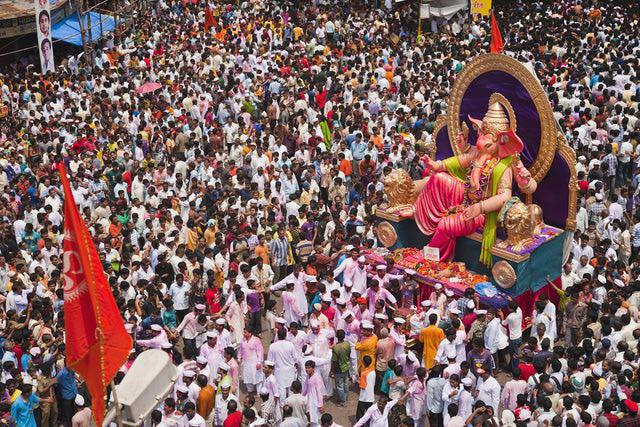
Lord Ganesha, affectionately called Ganapati, is commonly depicted in homes and offices throughout India as a chubby, smiling and a little mischievous God. His devotees scribe to Ganesha the ability to bestow wisdom and wealth upon us humans, thus making him probably the most popular deity in the Hindu pantheon. To repay Ganesha’s bounty, in India, especially in Maharashtra and nearby areas, the entire population celebrates the ten-day festival of Lord Ganesha’s birthday. The festival of Ganesh Chaturthi is celebrated all over India with great festivities and zest. It is celebrated as the birth anniversary of Lord Ganesha, the God of wisdom and prosperity.
The festival honors Ganesha, the elephant-headed God of the Hindu pantheon. During the ten days of Ganesh Chaturthi, the image of the God is worshipped and feted in most homes, temples and halls, and on the last day the images are taken in a procession and immersed in water. Fasting, feasting and distribution of sweets are important aspects of Ganesh Chaturthi rituals in India. Hindus pray to images of Lord Ganesha, large and small, many of them made specially for the occasion by cottage industries and street-side artisans. Even those that do not wish to keep the idols alive by daily prayers, offerings, and lighting oil lamps, immerse them in the nearest water body (rivers, lakes and the sea that are sacred to the Hindus). Ganesh Chaturthi falls on the fourth day of Bhadrapada (August/September) month of Indian calendar. The celebration of this festival is followed according to the Indian calendar and hence the month in the English calendar varies every year. The festival is celebrated for as many as ten days in areas like Maharashtra, Pune, and nearby areas.
Rakshabandhan
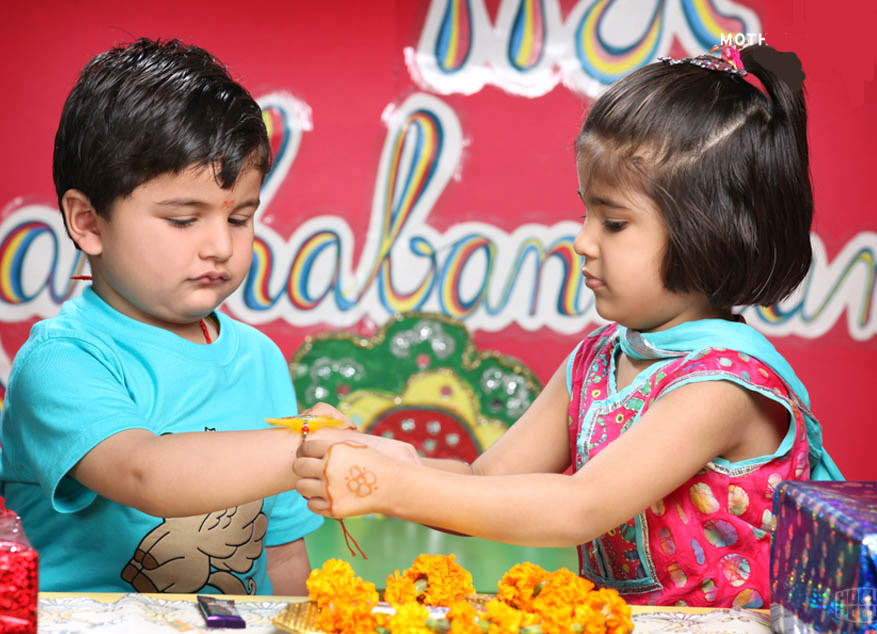
Rakshabandhan is an unspoken pledge exchanged between a brother and sister cementing their fraternal relationship. This also reinforces their protective bond against all ills and odds. Raksha Bandhan is celebrated on the day of Shravan Poornima that falls in the month of August every year. On this very day, the sisters tie a delicate, sometimes decorated, thread on the wrist of their brothers as a symbol of love and affection. This makes the brothers bound to protect their sisters from any trouble or wound. The chanting of a holy mantra by the sisters while tying the thread says, “I am tying a Raksha to you, similar to the one tied to Bali, the powerful king of the demons
Oh Raksha, be firm, do not waver”. The mantra recalls how the demon king Bali had become very powerful with the Rakhi on. The power of the mantra is supposed to protect the wearer from evil influences. This shows how dependent and secure a sister feels when she has a brother. Tying this Rakhi or Raksha signifies the re-strengthening of the bond between the siblings of opposite sexes. Raksha Bandhan is the most awaited festival of the year for every girl. It is celebrated in the month of August on the full-moon day known as the Shravan Poornima in India. The celebration of this festival is followed according to the Indian calendar, and hence the month in the English calendar varies every year.
Baisakhi
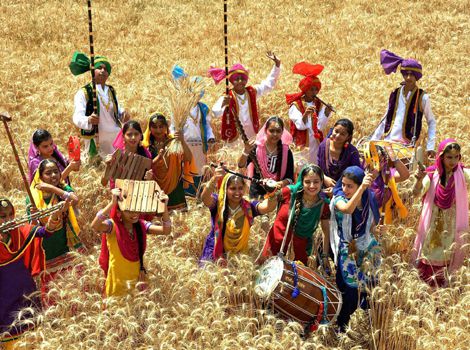
Several Indian festivals coincide with the harvest time and Baisakhi is one of them. Baisakhi is celebrated by the people of Punjab with vigor and joy. It is celebrated by different names and with different rituals almost all over India, when the Rabi crop is ready for harvesting. Baisakhi is also the day when the tenth Guru of the Sikhs, Guru Gobind Singh, founded the Khalsa Panth over three hundred years ago. The Vaishakha period of April and May is filled with festivals of fun, frolic and merry-making and Baisakhi, derived from the word Vaishakh, falls in this auspicious period. Based on the Indian solar calendar, this festival falls on April 13 every year and on April 14 once every 36 years. Other festivals celebrating the harvest are Bihu in Assam, Pongal in South India.
Pushkar Fair
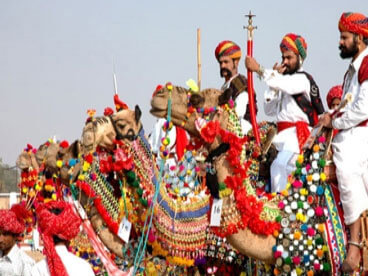
Held every year in the month of November, Pushkar fair is the ideal occasion to witness the charisma of Rajasthan in full bloom. Every ingredient that makes Rajasthan a distinct place can be spotted in the fair including men dressed in colorful traditional clothes, women in mirrored skirts and vivid shawls, embroidered clothes, exquisitely designed jewelry, pots and ornaments. This four-day long fair full of fun and frolic falls on the full moon of Kartik Purnima and offers an unique opportunity for a shopping spree while giving an edge to the consumer product marketing in rural Rajasthan.
Improved accommodation facilities have made it an International event A large camel fair in which traders from all over Rajasthan participate to parade, race and trade their camels, horses and cattle give it a fascinating touch. The acrobats, jugglers, snake charmers and fire-eaters will leave you mesmerized with their skilled performances. Cruise on a camel safari and get the real flavor of the fair.
Desert Festival
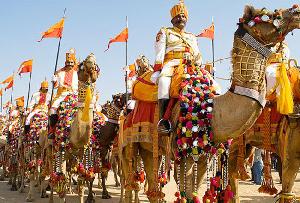
The otherwise sleepy town of Jaisalmer reverberates with enthusiasm and zeal during the Desert Festival that provides it with an occasion to parade its exuberant charm to the world. This colorful spectacle of dance and music showcases the rhythmic dances like Ghoomar, Gangaur, Gair, Dhap, Moria, Chari and Terahtal. The fire dancers are the special highlights of the festival. Held in the month of January-February the major attractions include turban-tying competition, Gair dancers and fire-dancers presenting enchanting displays of folk dance and music The various interesting contests including turban tying and Mr. Desert contest
The Camel races, acrobatics, dances and camel polo are sure to leave you spellbound. An awe-inspiring fusion of traditional dances backed by the folk music of the desert is sure to give you a time of your life. The major attraction of the festival remains the music and dance performance on the sand dunes.
Nagaur Fair
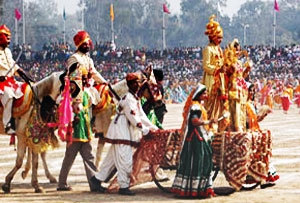
Nagaur awakes to the thronging of cattles, horses and camels during the time of cattle fair, which is reputed as one of the biggest in the country. The Nagaur bulls are renowned for their fleet-footedness and attract buyers from all over the world. Their owners with large moustaches and colorful costumes add a unique charm to the fair. Renowned for trading in cows, bullocks, camels and horses Held every year during the month of Magh (Jan-Feb) Provides an opportunity for a shopping spree to the locals The fair comes to an end with a series of exciting games including tug of
war, camel races and strains of ballads that create a joyful atmosphere. Mirchi Bazaar (Red Chilly Market) is the main attraction and wooden items, iron crafts and leather accessories are also available in abundance during the fair.
Camel Fair, Bikaner
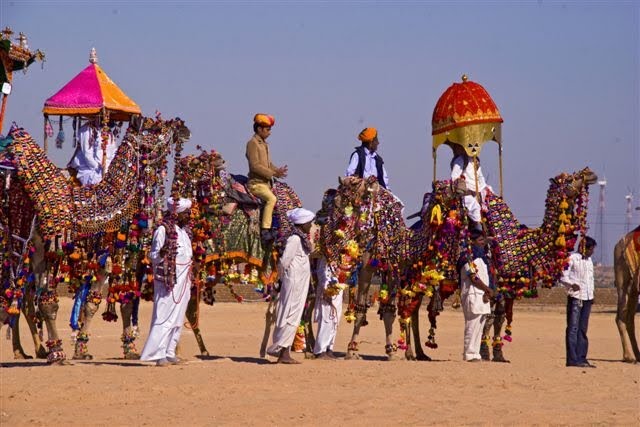
A unique blend of color, rhythm and melody. The Camel Festival begins with a colourful procession of bedecked camels, Ships-Of-The-Desert, in the red sandstone backdrop of the Junagarh Fort. The festivity advances to the open sandspreads of the Polo Grounds, followed by camel races, camel milking, fur cutting design, the best breed competition, camel acrobatics, camel bands and watching all this, are the gaping spectators. The camel display amazing foot-work, dancing gracefully to the slightest direction of their riders.
Colourful bridles, bejewelled necks, jingling anklets and long, lanky camel shadows on dusky sands, cast a magic spell. The jubilant, skirt-swirling Gair dancers, the awe inspiring Fire dance, and dazzling fire-works light up the fortified desert city of Bikaner.
Gangaur Festival

The most important local festival in Rajasthan, Gangaur is held about a fortnight after Holi and the celebrations go on for eighteen days. The festival is held in honor of Gauri, a manifestation of goddess Parvati, the wife of Lord Shiva. The festival is celebrated by girls and married women throughout Rajasthan. Images of Gauri are ornamented and offerings are made. This is also an auspicious time for young people to select their life partners. Colorful processions with the town band, horses, and elaborate palanquins make it a fascinating spectacle.
The Gangaur festival is celebrated throughout Rajasthan with great enthusiasm but the celebrations in Jaipur and Udaipur have their own special charm. The festival is also celebrated with great pomp and show in Bikaner, Jodhpur, Marathwara and Jaisalmer. Girls worship the goddess throughout the fortnight. Colorful images of Gauri, beautifully dressed and bejeweled, are taken out in a procession accompanied by the town band. A boat procession is taken out on the Pichola Lake in Udaipur. Women balancing several brass pitchers on their heads add to the gaiety of the Udaipur celebrations. Thousands of people from the countryside come to take part in the procession of Gangaur, which goes around from village to village. Tribal men and women get the opportunity to meet and interact freely and during this time, they select partners and elope to marry. An unusual, romantic custom sanctioned by the community, it helps many young people find their life partner.
Hemis Festival, Ladakh
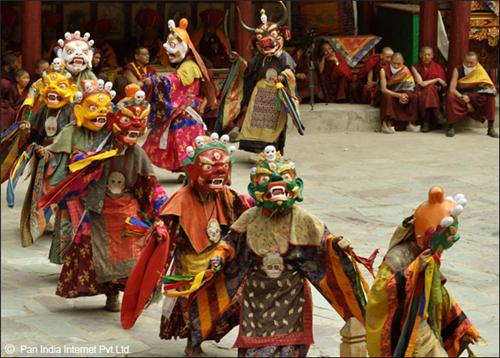
The courtyard of Hemis- the biggest Buddhist monastery in Ladakh, is the stage of the famous Hemis Festival, that celebrates the birth anniversary of Guru Padmasambhava. Splendid masked dances are performed to the accompaniment of cymbals, drums and long horns. A colourful fair, displaying some beautiful handicrafts, is the special highlight of the festival.




